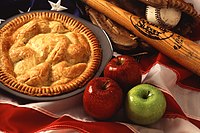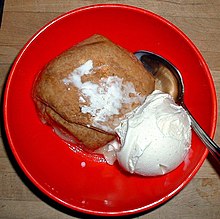Cuisine of the Pennsylvania Dutch
| Part of a series on |
| American cuisine |
|---|
 |
Pennsylvania Dutch cuisine is the typical and traditional fare of the Pennsylvania Dutch. According to one writer, "If you had to make a short list of regions in the United States where regional food is actually consumed on a daily basis, the land of the Pennsylvania Dutch - in and around Lancaster County, Pennsylvania - would be at or near the top of that list," mainly because the area is a cultural enclave of Pennsylvania Dutch culture. Pennsylvania Dutch cuisine reflects influences of the Pennsylvania Dutch's German heritage, agrarian society, and rejection of rapid change.[1]
It is extremely common to find Pennsylvania Dutch cuisine throughout the Philadelphia/Delaware Valley region.
Techniques
In the 18th century baking was still done in wood-fired ovens that produced inconsistent results and could easily become too hot. The Pennsylvania Dutch baked pastries on cabbage leaves to provide some protection from hot spots that coulddevelop in the oven.[2]
Soups
Soups, often featuring egg noodles, are characteristic of the Pennsylvania Dutch.[1] The Pennsylvanian Dutch homes have traditionally had many broths on hand (vegetable, fish, poultry, and meat) from the saving of any extra liquids available: "The Pennsylvania Dutch developed soup making to such a high art that complete cookbooks could be written about their soups alone; there was an appropriate soup for every day of the year, including a variety of hot and cold fruit soups."[3] Soups were traditionally divided into different categories, including Sippli or "little soup" (a light broth), Koppsupper or "cup soups", Suppe (thick, chowder soups, often served as a meal with bread), and G'schmorte (a soup with no broth, often like a Brieh (Brei) or gravy).[4]
Pennsylvania Dutch soups are often thickened with a starch, such as mashed potatoes, flour, rice, noodles, fried bread, dumplings, and Riwwels or rivvels (small dumplings described as "large crumbs" made from "rubbing egg yolk and flour between the fingers"), from the German verb for "to rub."[4]
Pennsylvania Dutch specialties




Beverages
Dishes
- Amish potato salad
- Apple butter
- Baked Apple - A cored and peeled apple, covered in a pie-crust, dusted with sugar or cinnamon, and baked. Served in a bowl with milk. Sometimes eaten as dessert, but generally a meal in and of itself.
- Beef or venison jerky
- Bova Shankel (translated as "boy's legs" from Pennsylvania Dutch "buwe schenkel")
- Brown butter noodles - egg noodles that have been combined with butter that was melted and browned in a pan
- Hot bacon dressing - Cooked, drained, crumbled bacon in a thickened sweet dressing, served hot over fresh salad greens; often used with dandelion greens to offset their tart taste.
- Bacon gravy
- Chicken and waffles
- Chicken corn soup - Made with egg noodles and sometimes saffron, which has been cultivated in Pennsylvania Dutch country since the early 19th century.[1] Sometimes an addition is rivels, small dumplings.
- Chow-chow
- Cole slaw
- Corn fritters
- Cup cheese
- Gingerbread, ginger snaps, ginger cake, and pot roast spiced with ginger and other aromatic spices[5]
- Hamloaf - A meatloaf-like entity made of ground ham, often baked with brown sugar on top, and lacking the spices and bread-crumbs found in meatloaf.
- Hog maw - pig's stomach, called Seimaaga in the Pennsylvania Dutch dialect
- Lebanon bologna
- Peanut butter schmear
- Pepper cabbage
- Pork and sauerkraut
- Potato filling
- Potato rolls
- Pot pie - Not the baked pie with a pastry top, but a meat stew with large noodles (pot pie squares); often features chicken, flour, salt, vegetables (such as celery, onion, and carrots) as well as spices (such as parsley, thyme, black pepper, and bay leaf).[1]
- Pretzel
- Red beet eggs (pickled beet eggs)
- Sauerbraten - Or sour roast, is any one of various meats and spices that are marinated for several days in vinegar or wine, vegetables are added to the marinade during the final day. Sauerbraten was traditionally made using horse meat, but beef or other cuts of meat are now favored. It is often served with dumplings and red cabbage. Sauerbraten remains very popular throughout Germany.
- Schnitz un knepp
- Scrapple
Desserts
- Angel food cake
- Apple dumplings
- Dutch Baby
- Church spread - Made from molasses or corn syrup, marshmallow cream, and peanut butter. It is often found at Amish church services and community events.
- Cracker Pudding - Thickened with saltine crackers
- Fastnachts
- Funnel cake
- Funny cake - A combination of pie and cake that is made by baking a cake surrounded by pie crust, marbled throughout with chocolate streaks.
- Whoopie Pie
- Montgomery pie
- Moravian sugar cake
- Shoofly pie - A molasses crumb cake with a pie crust for easier eating.
- Sugar cookies
See also
Notes
- ^ a b c d David Rosengarten, It's All American Food: The Best Recipes For More Than 400 New American Classics (2003). Hachette Digital.
- ^ Fieldhouse, Paul. The World Religions Cookbook. Greenwood Press. p. 37.
- ^ William Woys Weaver, Sauerkraut Yankees: Pennsylvania Dutch Foods & Foodways (2nd ed.) (2002), p. 93.
- ^ a b William Woys Weaver, Sauerkraut Yankees: Pennsylvania Dutch Foods & Foodways (2nd ed.) (2002), p. 94.
- ^ Evan Jones, American Food: The Gastronomic Story (1975). Dutton: p. 77.
